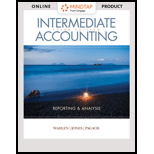
Ascertain the following ratios of Company B:
- 1. Earnings per share.
- 2. Gross profit margin.
- 3. Operating profit margin.
- 4. Net profit margin.
- 5. Total assets turnover ratio.
- 6. Return on assets ratio.
- 7. Return on common equity.
- 8. Receivables turnover ratio.
- 9. Interest coverage.
Explanation of Solution
Earnings per share (EPS): The amount of net income available to each shareholder per common share outstanding is referred to as earnings per share (EPS).
Gross margin (gross profit): Gross margin is the amount of revenue earned from goods sold over the costs incurred for the goods sold.
Net margin: This ratio gauges the operating profitability by quantifying the amount of income earned from business operations from the sales generated.
Asset turnover ratio:
The Asset turnover is a contrast to the profit margin ratio and it is calculated to determine the net sales and average total assets. Use the following formula to calculate the asset turnover ratio:
Return on assets:
Return on assets is the ratio of the net income, and interest expense to the average total assets. The
Accounts receivable turnover:
Accounts receivable turnover is a liquidity measure of accounts receivable in times, which is calculated by dividing the net credit sales by the average amount of net accounts receivables. In simple, it indicates the number of times the average amount of net accounts receivables has been collected during a particular period.
Average collection period:
Average collection period indicates the number of days taken by a business to collect its outstanding amount of accounts receivable on an average. It is otherwise known as days to collect.
Compute the ratio as follows:
- 1. Calculate the earnings per share of Company B:
- 2. Calculate the gross profit margin of company B:
- 3. Calculate the operating profit margin of company B:
- 4. Calculate the net profit margin of company B:
- 5. Calculate the total asset turnover ratio of Company B:
Working note (1):
Calculate the value of average total assets.
- 6. Calculate the return on total assets of Company B:
Working note (2):
Calculate the value of interest expense.
- 7. Calculate the return on common equity of Company B:
Working note (3):
Calculate the average shareholder’s equity.
- 8. Calculate the receivable turnover of Company B:
Working note (4):
Compute the net credit sales:
Working note (5):
Compute the average net receivable:
- 9. Calculate the interest coverage of Company B:
Want to see more full solutions like this?
Chapter 5 Solutions
INTERM.ACCT.:REPORTING...-CENGAGENOWV2
- Expert need your helparrow_forwardI am trying to find the accurate solution to this financial accounting problem with appropriate explanations.arrow_forwardA firm has net working capital of $1,450, net fixed assets of $5,220, sales of $12,750, and current liabilities of $1,880. How many dollars worth of sales are generated from every $1 in total assets? a. $2.92 b. $1.49 c. $2.36 d. $1.50 e. $1.37arrow_forward
- How can I solve this financial accounting problem using the appropriate financial process?arrow_forwardStellar Systems Logistics purchases a new cargo van for $48,000. The sales taxes are $3,600. The company name is custom-wrapped on the sides of the van for $1,200. The van's annual registration fee is $200. Before use, the van undergoes a required inspection costing $350. What amount should Stellar Systems Logistics record as the cost of the new van?arrow_forwardPlease provide the answer to this general accounting question using the right approach.arrow_forward
 Intermediate Accounting: Reporting And AnalysisAccountingISBN:9781337788281Author:James M. Wahlen, Jefferson P. Jones, Donald PagachPublisher:Cengage Learning
Intermediate Accounting: Reporting And AnalysisAccountingISBN:9781337788281Author:James M. Wahlen, Jefferson P. Jones, Donald PagachPublisher:Cengage Learning Cornerstones of Financial AccountingAccountingISBN:9781337690881Author:Jay Rich, Jeff JonesPublisher:Cengage Learning
Cornerstones of Financial AccountingAccountingISBN:9781337690881Author:Jay Rich, Jeff JonesPublisher:Cengage Learning Managerial Accounting: The Cornerstone of Busines...AccountingISBN:9781337115773Author:Maryanne M. Mowen, Don R. Hansen, Dan L. HeitgerPublisher:Cengage Learning
Managerial Accounting: The Cornerstone of Busines...AccountingISBN:9781337115773Author:Maryanne M. Mowen, Don R. Hansen, Dan L. HeitgerPublisher:Cengage Learning Managerial AccountingAccountingISBN:9781337912020Author:Carl Warren, Ph.d. Cma William B. TaylerPublisher:South-Western College Pub
Managerial AccountingAccountingISBN:9781337912020Author:Carl Warren, Ph.d. Cma William B. TaylerPublisher:South-Western College Pub Financial And Managerial AccountingAccountingISBN:9781337902663Author:WARREN, Carl S.Publisher:Cengage Learning,
Financial And Managerial AccountingAccountingISBN:9781337902663Author:WARREN, Carl S.Publisher:Cengage Learning, Financial AccountingAccountingISBN:9781337272124Author:Carl Warren, James M. Reeve, Jonathan DuchacPublisher:Cengage Learning
Financial AccountingAccountingISBN:9781337272124Author:Carl Warren, James M. Reeve, Jonathan DuchacPublisher:Cengage Learning





